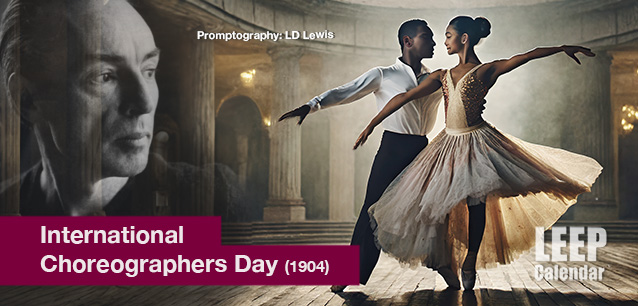 AD
AD
Today is: December 20
Scroll to explore events active on this date.
Additional Events on LEEP
LEEP INK FEATURES

August? Absolutely!
In August, we live through the Dog Days of Summer. It's hot and often humid, and those who can leave for better climates do. Down south, winter is in full force. August is also known as "the ...

In The Heat of July: July 2025 Events
Is it hot enough (or cold enough if you're below the equator) for you yet? There is actually a day for that! Like every month, I pick a diverse collection of events you may or may not know about. This ...

May Blooms: Events in May 2025
Along with October, May is one of the most densely packed months of the year. It's before the summer humidity and the last whole month of the school year. The weather is warming in t...
About International Choreographers Day
Career , Entertainment
Ends: Jan 09, 2025
DESCRIPTION:
International Choreography Day marks the birthdate (in the Julian calendar used by the Russian empire at the time) of George Balanchine on January 9, 1904, in Saint Petersburg, Russia. He is affectionately called "Mr. B." in the ballet community.
Balanchine is the reason for the word choreography, a term coined to describe the revolutionary dancing he created for the Rogers and Hammerstein play "On Your Toes," which debuted on stage on April 11, 1936. He is also considered the father of American ballet.
Choreography is the art of designing movement sequences that specify motion and form. The concept began with court dances and folk traditions, gradually refining into an art form through the adoption of ballet in Renaissance Italy and France. As ballet evolved, directors experimented with storytelling, musicality, and expressive movement. Balanchine took ballet to the next level.
MR. B COMES TO BROADWAY
Balanchine hails from a classical dance background. He trained at the Imperial Ballet School in Saint Petersburg and later worked in Diaghilev's Ballets Russes, one of the most influential ballet companies of the 20th century. His early work included a fusion of classical technique with avant-garde concepts.
In 1933, Balanchine moved to the United States. By 1935, he was commissioned to orchestrate the groundbreaking dance scenes in the Broadway play "On Your Toes." As mentioned above, the term choreography was coined to describe his work. It was so good the world needed a new word.
Twelve years later, he co-founded the New York City Ballet in 1948, which became a pivotal platform for his choreographic innovations. His collaboration with composer Igor Stravinsky in the 1950s and 1960s resulted in iconic works like "Agon" and "The Firebird," where the integration of contemporary music and innovative choreography pushed the boundaries of what ballet could be.
MR B'S CHOREOGRAPHIC STYLE
Balanchine diverged from the narrative-driven ballets of the 19th century, focusing instead on "plotless" ballets where movement, music, and pure form narrated the story, known as neoclassical ballet. It stripped away elaborate costumes and sets, emphasizing speed, athleticism, and precision. This approach highlighted the dancers' technique and the music's rhythms, offering a fresh perspective on ballet that contrasted sharply with the opulence and narrative focus of traditional ballets like those of Marius Petipa.
Balanchine's influence extended beyond his choreographic works. He was a master teacher, emphasizing a distinct aesthetic in his dancers, marked by high extensions, speed, and precision. His teaching methods and artistic philosophy greatly influenced the training of dancers in America and around the world. International Choreography Day is a tribute to him and his legacy.
VIDEOS
SUPPORTING DOCUMENTS
Currently, this event does not have supporting documents.
ADDITIONAL IMAGES
Currently, this event does not have supporting images.
Where would you like to go now?
 AD
AD


/footer-logo.svg)
